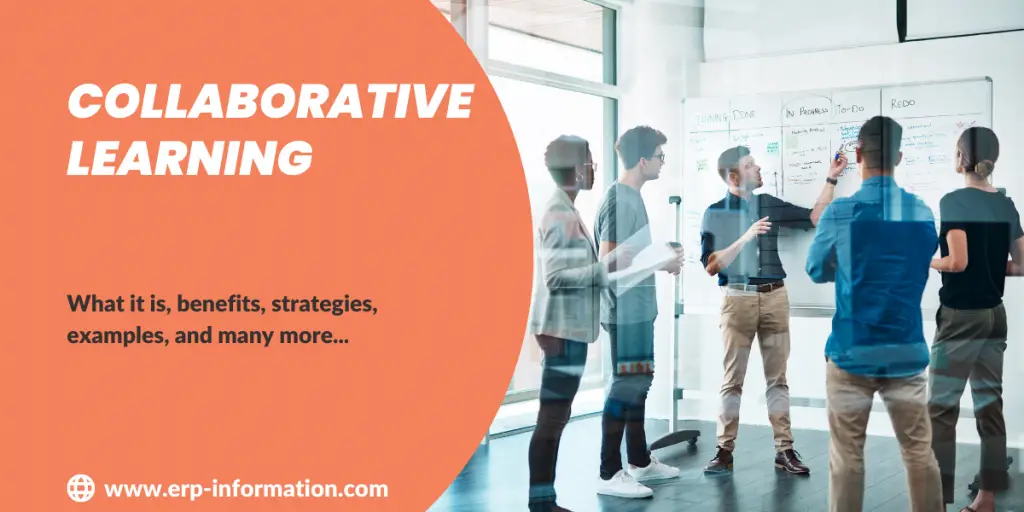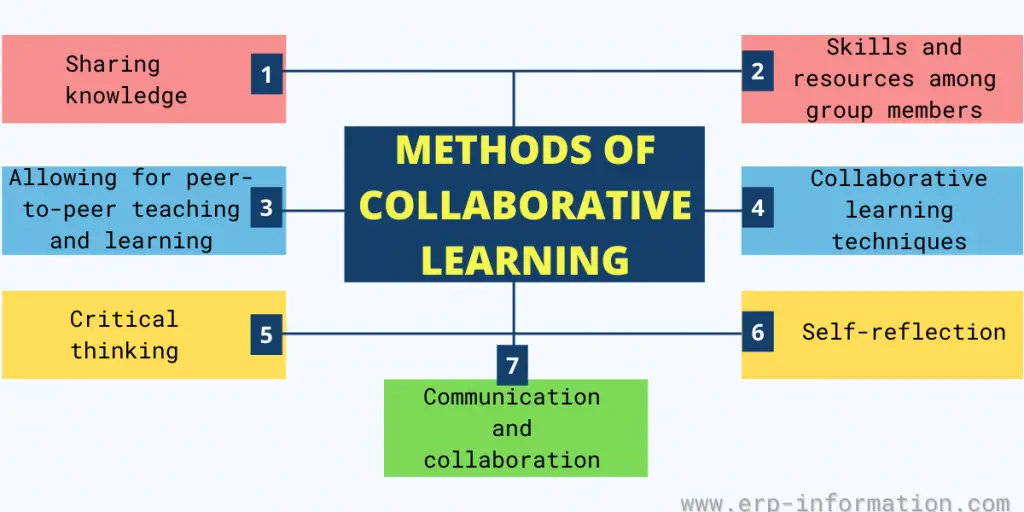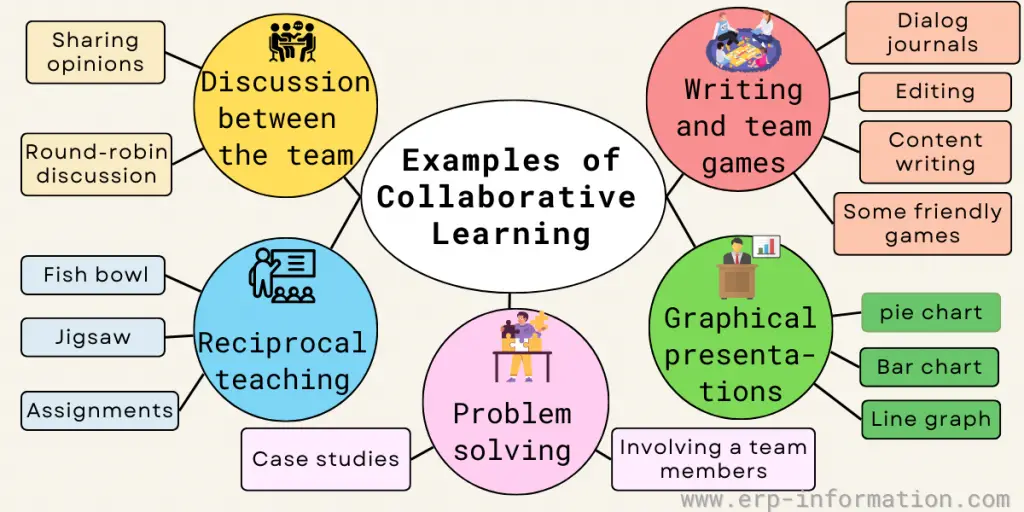Many of you are thinking about collaborative learning and why we need it. How can we implement it in our learning process, and what are its benefits?
This blog post will discuss collaborative learning’s meaning, how it will be helpful in effective learning, and many more.
What is Collaborative Learning?
It is a form of active learning in which groups work together to achieve a shared goal. This type of learning encourages company employees, students, and teachers to problem-solve and think creatively.
This is an engaging way for learners to deepen their knowledge by exchanging ideas and working together. Whether talking through a lecture or tackling tasks across the globe, these methods help foster skills beyond traditional educational approaches.
Collaborative learning in organizations
Collaborative learning culture effectively allows organizations to share knowledge, build relationships and increase productivity.
It involves creating a shared environment where members of the organization can explore ideas, provide feedback and collaborate on projects. It promotes creative problem-solving, encourages collaboration among team members, and improves team communication.
By utilizing this learning technique, organizations can create an atmosphere of mutual respect that leads to more productive work practices. Some of its methods are as below.
It involves
- Sharing knowledge
- Skills and resources among large group members
- Allowing for peer-to-peer teaching and learning
- Its techniques also support independence.
- Critical thinking
- Self-reflection
- Communication and Collaboration
These methods equip students /employees with the skills they need to succeed in today’s competitive academic environment.
Benefits of Collaborative Learning
It will provide benefits to employees of an organization and individuals.
Improves communication and interpersonal skills
It encourages classroom collaboration and allows for open dialogue among peers. Through this type of learning, team members can connect on a deeper level and practice engaging in conversations beyond the materials they are learning.
- They learn how to accept different perspectives, problem-solve together, and express ideas clearly.
- It also encourages greater levels of understanding and respect between individuals, as there is ample opportunity to listen, be heard, and learn from one another.
- Collaboration among team members or class members can build trust and empathy, which goes well beyond what is taught in the classroom setting and helps prepare employees/students for functioning in today’s contemporary society.
Increases problem-solving capacity
It has been proven to be an effective tool in boosting problem-solving skills among team members or students. This type of learning requires participants to collaborate and discuss their thoughts with each other and present the best possible solution to a given problem.
- Learners learn from each other’s perspectives and gain additional insight into different approaches that could yield more efficient results.
- Collaboration also encourages out-of-the-box thinking by allowing participants to draw inspiration from one another, resulting in an improved understanding of problem-solving strategies.
- This approach helps learners become more successful in tackling complex issues and preparing them for future challenges.
Enhances creativity and deeper understanding
It is an effective approach to broadening understanding and imagination.
When faced with a particular subject matter, it encourages team members to work together to expand their perspectives on the topic.
- This reinforces comprehension by having individuals share, challenge, and exchange ideas which can help foster understanding that goes beyond conventional teaching.
- Additionally, the collective power of collaboration helps develop creative ways of processing material as any singular collaborator is limited within the scope of an individual’s capacity; with a collective effort, broader solutions can be achieved.
- It provides a perfect platform to push the boundaries and create something multifaceted while increasing insight into topics that may have otherwise been deemed straightforward or dull.
Better knowledge retention and comprehension
This learning method is one of the most effective ways to understand and retain knowledge. By learning together, students or employees can better comprehend the content by hearing explanations from their peers and engaging in a dialogue about it.
- It allows learners to practice articulating their thoughts on what they have learned and thinking through different perspectives that help shape their understanding.
- Collaborating with others can also make learning more enjoyable and meaningful by creating a safe space for mutual support through discussion and exploration.
- Through this, learners are more likely to make connections between concepts, think critically, and develop insights into the material being learned.
Efficient time management and organization skills
It encourages students or employees to work with teammates, allowing them to learn directly from each other and form meaningful relationships.
- Collaboration helps develop effective communication and interpersonal skills while fostering an environment of open discussion and constructive criticism.
- Furthermore, it encourages individuals to practice efficient time management, as they need to create a structure that works for everyone involved.
- This cooperation also pushes learners to be better organized as they identify and divide tasks accordingly.
- Collaborating with fellow peers raises the stakes no matter the task and can lead to a much deeper understanding for all participants.
- It is not just about the outcome; it’s about strengthening bonds among teammates and fostering valuable time management and organization lessons that will serve them long after the project ends.
Strengthening teamwork
It has become an increasingly common practice in the modern workplace. This useful technique encourages employees to work toward a common goal or task, allowing everyone to improve their skills, knowledge, and team building.
- It strengthens teamwork by allowing team members to share ideas, input, and resources they possess as individuals.
- This helps break down traditional communication barriers, so all group members can more effectively collaborate and build relationships, leading to greater success in achieving goals.
- When quality collaboration is achieved through collaborative learning, teams can perform better than ever before, leading to higher productivity and long-term success for individual members and the organization.
Strategies to follow in Collaborative Learning
- Equal opportunities for all learners
- Team building and reflection exercise
- Establish ground rules, and all should follow the rules
- Assigning roles to team members and changing the rules periodically
- Encouraging the learners to rate other’s qualitative and quantitative outcomes
- Evaluating other’s work with specific reasoning for positive outcomes
- Instructions to handle their own issues themself
Collaborative Learning Examples
The below chart shows collaborative learning activities
- Discussion between the team: Sharing opinions, round-robin discussion, etc
- Reciprocal teaching: Collaborative learning activities like a fish bowl, jigsaw, assignments, etc
- Problem-solving: Case studies involving a team to solve problems, etc
- Graphical presentations: Present their plans and projects in easily understandable graphics.
- Writing and team games: Dialog journals, editing, content writing, and some friendly games.
Disadvantages of Collaborative Learning
Not suitable for Introverted students/learners
This learning system is not suitable for students/learners who like to think carefully before they answer. They may not feel comfortable speaking up in social situations.
Need Guidance
Students/learners need to learn how to work together. Teachers/mentors can help them learn how to get along with people with different learning styles and ensure everyone is included in the group.
Difficult to assess individuals
It can be hard to decide how well each group member did their work. Sometimes, one person may think that another person didn’t work enough or worked too much, affecting their grade.
Conflict between the group members
There is a possibility of differences of opinions and conflict between the same group members. This may create uncomfortable working conditions.
Uneven effort in group projects
Only a few will contribute their complete effort; some members may contribute less than others. One or two will take a handful of work, and others will be rewarded.
Theories of Collaborative learning
Vygotsky s Social development theory
Vygotsky had an idea about learning. He said that people learn by being around others and talking to them. He thought conversations with smart people help us learn and understand things better.
Vygotsky’s social learning theory discusses the Zone of Proximal Development. Imagine two different zones – one that shows what you can do and another that shows what you cannot do. Between those two zones is a third zone – the Zone of Proximal Development. This is what you can learn with help from someone else. This happens with collaborative learning.
Piagets Cognitive development theory
Piaget came up with the idea of schemas. These are like pieces of knowledge that help us understand complicated ideas. Schemas also represent actions that have a certain meaning. We already know some schemas, like when babies suck their thumbs. Others come from experiences and things we learn over time.
Kegnas cognitive development theory
Kagan says the subject framework does not let you honestly think about yourself. It is too set and doesn’t give you the freedom to be objective. Instead, it includes your ideas, actions, and thoughts about life.
The object framework lets you step away from an idea so that you can look at it differently. You can think about it without being biased or influenced by your feelings. This process of switching frameworks helps people learn more.
FAQs
What is the difference between collaborative learning and cooperative learning?
In collaborative learning, a group of learners will work together on the project and must take responsibility completely. Cooperative learning is a small team work with individual efforts and responsibility taken by teachers and students.
Conclusion
Collaborative learning has the potential to revolutionize the way we learn and teach. It encourages critical thinking, learning new concepts, problem-solving, creativity, communication, and collaboration skills, allowing learners to gain a deeper understanding and knowledge retention of their subject matter.
Through this type of learning, students/employees can better prepare themselves to be successful in today’s competitive academic environment.
We hope this blog post has successfully presented the importance of collaborative learning for employees of organizations or students.


